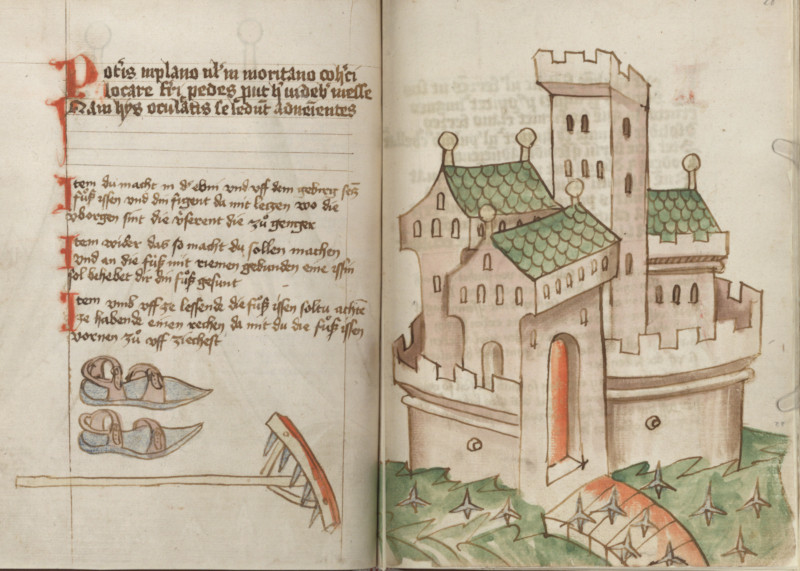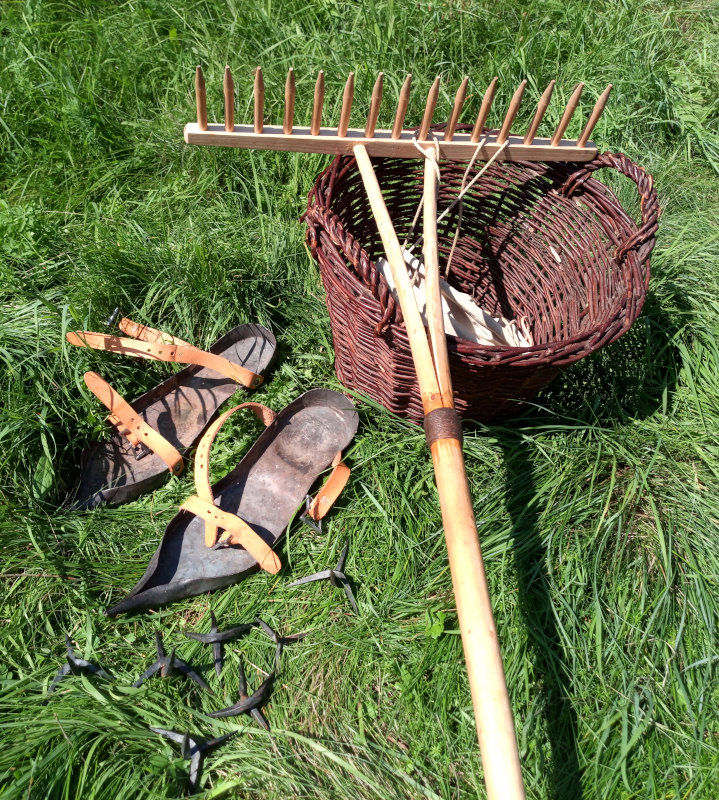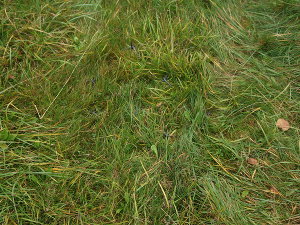
Caltrops or mantraps are simple and cheaply producible defensive weapons of enormous tactical effectiveness.
The first written evidence of their use dates back to the 4th century BC in Persia, but their invention probably goes back much further. Their tactical utility has survived to this day, which is why they are still used by partisans, armies, intelligence services and police forces, especially against vehicles with pneumatic tyres. They can be made by even inexperienced blacksmiths in a short time and in large quantities. They are inconspicuous obstacles to approach that can easily be deployed on deployment fields and are difficult to detect in fields, meadows and fields for attacking forces. Their main objective is to injure and incapacitate opponents, at least for a certain period of time, and to disorganise opposing line-ups. They are effective against infantrymen and horses alike. Barbed spikes make it difficult to easily remove kicked-in spikes or make removal in the field impossible altogether. In addition, the fighters who are writhing on the ground, groaning with kicked-in caltrops, demoralise the following comrades who still have the same path ahead of them.1)
Historical as well as modern footwear has little to offer in the way of protection against caltrops, at best modern safety shoes with anti-puncture soles offer safe protection against them. The sharp points easily pierce through leather and feet. At best, the victim can pull a barbless caltrop out of his foot and limp on with pain. With barbed spikes, this is no longer possible without additional injury. The fighter is so severely bound for some time that he becomes an easy target for shooters or foot troops, hindering or stopping other comrades in the process.
Another way of setting traps in front of the enemy is to pack them in containers filled with explosives or unslaked lime, so called Fire and Lime Pots, and throw them at the advancing army by means of throwing devices such as hand slings, trebuchets or catapults.2)
For the year 1471, the treasury accounts of the city of Hamburg record expenditure by the city council of „... 6 Fl. 12 ß pro vurpyle, 10 lode et votangell per dominos Henningum Buringh et Everhardum vom Kroge.” (... 6 Fl. 12 ß for lead shots, 10 lode and caltrops to Mister Henningum Buringh and Everhardum vom Kroge)3) A fortification order issued by the Hamburg City Council on 1 December 1561 stipulates that on the city wall and in the armoury there should be: cannons, powder, lead shots, slow matches, tinder, [military] fireworks, caltoprs, lintstoks, fire strikers, pinch-bars for use with the cannons.4) In 1642, according to the inventories analysed, there were no less than 23,959 mantraps stored in the municipal armouries and bulwarks of Hamburg.5) Due to their generally widespread use, we assume that foot rods were also in use in Hamburg earlier on.
Countermeasures
 In order to defend against caltrops, authors of historical war books regularly suggest iron soles, which are strapped under the shoes in a similar way to pattens, and which, as with modern safety shoes, prevent puncturing of the outsole. In Kyeser's Bellifortis of the Cologne Historical Archive of 14436) their use is described::
In order to defend against caltrops, authors of historical war books regularly suggest iron soles, which are strapped under the shoes in a similar way to pattens, and which, as with modern safety shoes, prevent puncturing of the outsole. In Kyeser's Bellifortis of the Cologne Historical Archive of 14436) their use is described::
„Item wider das so macht du sollen machen und an die füß mit riemen gebunden eine issin sol behebet dir din füß gesunt”
(Approximately: Against this [caltrops] you shall make soles and bind them to your feet with straps, an iron sole will keep your feet healthy.)
We do not know of any surviving originals, which is why it remains unclear whether these iron soles were widely used. Even if they did exist, they would probably have been the exception in battles, available at most to pioneers or reconnaissance troops. The mass of combatants will not have had the benefit of them.
 Occasionally, the authors of war books suggest roller-like objects rolled across the field to pick up the caltrops. The material of these rollers is also unclear. We consider wooden trunks rather unlikely due to the hardness of the material. Conceivable would be rollers made of sturdy linen or heavy (wrapping) wool, densely stuffed with straw or other material, in which the caltrops could easily get stuck and be pulled out of the ground. The dotted lines on the roller depicted in Kriegsbuch and Bellifortis ÖNB Cod. 3069 Fol 21v7) or the Büchsenmeisterbuch of the Bayerische Staatsbibliothek Munich Cgm 600 on Fol. 138) could at least indicate a seam. It is also conceivable, however, that wooden trunks were used to flatten the caltrops or to sink them into the ground.
Occasionally, the authors of war books suggest roller-like objects rolled across the field to pick up the caltrops. The material of these rollers is also unclear. We consider wooden trunks rather unlikely due to the hardness of the material. Conceivable would be rollers made of sturdy linen or heavy (wrapping) wool, densely stuffed with straw or other material, in which the caltrops could easily get stuck and be pulled out of the ground. The dotted lines on the roller depicted in Kriegsbuch and Bellifortis ÖNB Cod. 3069 Fol 21v7) or the Büchsenmeisterbuch of the Bayerische Staatsbibliothek Munich Cgm 600 on Fol. 138) could at least indicate a seam. It is also conceivable, however, that wooden trunks were used to flatten the caltrops or to sink them into the ground.
Another possibility is to use a common wooden rake, as used in agriculture, to rake out the fishing rods from the field. Kyeser's Bellifortis of the Historic Archive Cologne of 1443 advises this on fol. 27v6):
„Item und uff gelessende die füß issen soltu achte ze habende einen rechen damit du die füß issen vornen zu uff ziechest”
(Approximately: Item to pick up leg irons you should take care to have a rake to pull up the leg irons in front of you.)
Reconstruction Attempts
The pattern of the iron soles was taken from a pair of shoes with a generous allowance for the edge to be beaded. The shape with the pointed beaks is based on illustrations from historical manuscripts Bellifortis and Kriegsbücher, first of all Konrad Keyeser's Bellifortis of the UB Frankfurt/M Ms germ qu 15, Fol 174r ca. 146010) and of the Historic Archive Cologne HAK Best 7020 W 232, Fol 27v of 14436), as well as Johannes Bengedan's: Kriegskunst von ca 1440-14519). Since original preserved iron soles are not known so far and consequently their actual forms are not verifiable, we have adopted the beak form depicted there, even if they were possibly only a representational convention in the works to show the reader that they were soles. The iron soles themselves were roughly cut out of 2 mm sheet steel and first cold and then hot driven into shape. The buckles were sawn out of 5 mm flat steel, filed and ground. The corners of the buckles are decorated with file notches. Finally, the buckles were sewn to leather straps and these were riveted to the iron soles.
Practial Trials
 Our reconstructed iron soles were put to the test in September 2023 at the Feldlager at the Brandenburg in Lauchröden. In a simulation, parts of the deployment field, meadows about 10 cm high, were scanned for caltrops hidden in the grass before the battle and cleared of them.
Our reconstructed iron soles were put to the test in September 2023 at the Feldlager at the Brandenburg in Lauchröden. In a simulation, parts of the deployment field, meadows about 10 cm high, were scanned for caltrops hidden in the grass before the battle and cleared of them.
Strapped tightly under the shoes, meadows or fields can be walked on relatively well and safely with the iron soles, despite their smooth treads with slightly forged surfaces. Sloping meadows with a gradient of over 20% are no problem, nor is negotiating embankments, as long as existing uneven ground is used. In slippery places, the soles must be tilted to provide a little more grip. On slippery or stony ground, such as trails or paved paths, they hardly provide any grip, but here they are only necessary to a limited extent, as the foot pegs are usually more visible. In our case, strapping the soles by means of two straps across the instep and the forefoot has proven to be completely sufficient, as the shoe is held in place by the raised standing seams of the sole edges. Heel straps, as shown in many illustrations, have not been necessary.
The beaks worked out on the soles did not offer any discernible advantages in the field, such as easier sharing of tufts of grass when roaming the meadow. No negative effects have been observed so far either, except that they make walking on firm, level ground more difficult.
Stepping on a caltrop with the iron soles is clearly noticeable. The tip of the caltrop slides off the sole, or bends, or the caltrop is pressed into the ground. Afterwards, it can be easily picked up. With a little practice, it should also be possible to distinguish caltrops from stones when stepping on them.
After the first one-hour trial, iron soles seem to be an effective and practicable protective equipment for pioneers who clear deployment fields of hidden caltrops without running the risk of injuring themselves on them. Further trials are planned, and the findings will be successively added here.
Historic Sources
References
- Flügel (2010)
- Geibig (2012) pp. 31-46
- Kämmereirechnungen der Stadt Hamburg: Bd. III 1471-1500, p. 37
- Gaedechens (1872) p. 4
- Neddermeyer (1832): S. 60-62
- Kyeser: Bellifortis / Dachsberger (1443) Historisches Archiv Köln, Best 7020 W 232, Fol 27v.
- Kriegsbuch und Bellifortis (1411) ÖNB Cod. 3069, Fol. 21v
- Büchsenmeisterbuch (1. Viertel 15. Jh.) BSB München Cgm 600, Fol. 13
- Bengedans (1450) Fol. 47v
- Keyeser (um 14460): Bellifortis. UB FrankfurtM Ms germ qu 15, Fol 174r
Currency symbols: Fl. Florin (Gilder) / ß solidus (Shilling)
Text, Andreas Franzkowiak. Photos: Andreas Vollborn-Rahn, Daniel Burger, Andreas Franzkowiak,
Photo Caltrops Fornsalen Museum: Wolfgang Sauber, Lizenz: GDFL/CC-BY-SA-3.0


























